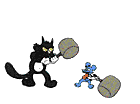I'm almost sure he recorded three tracks seperately -- track 1--the chanter; track 2--the drones; track 3--the regs. And that's the reason why he must have faded the endings (you can't end them at the same exact time).
The reason why he might have recorded seperately would be to keep the drones from wavering while playing the chanter's highest notes--if you know what I mean. And volume--three or four microphones aimed at the instrument would allow the recording engineer to balance or adjust the volumes between the three parts, but if that were the case, there'd be no need to fade. Then there's the possiblility of adding certain reg notes which might be difficult to get perfect while playing the whole instrument at the same time -- but surely Brian could do that easily enough, although it can be next to impossible to play the low notes of the regs at the same time as playing the low notes of the chanter--esp C and B sets!!
Another clue to his (possibly) recording the three parts seperately is the way the tunes start. You hear no bellows or air, nor do you hear the normal sound of the reeds when the drones are switched on or when the drones and chanter begin at the same instant (not that a piper has to ever do that--I understand). It's like the drones were already humming when the recorder began.
No criticism, just looking at some possible reasons why all the fading and why recording on seperate track might make one sound better. BTW, anyone ever tried a pitch corrector on the upper or lower E after recording?
